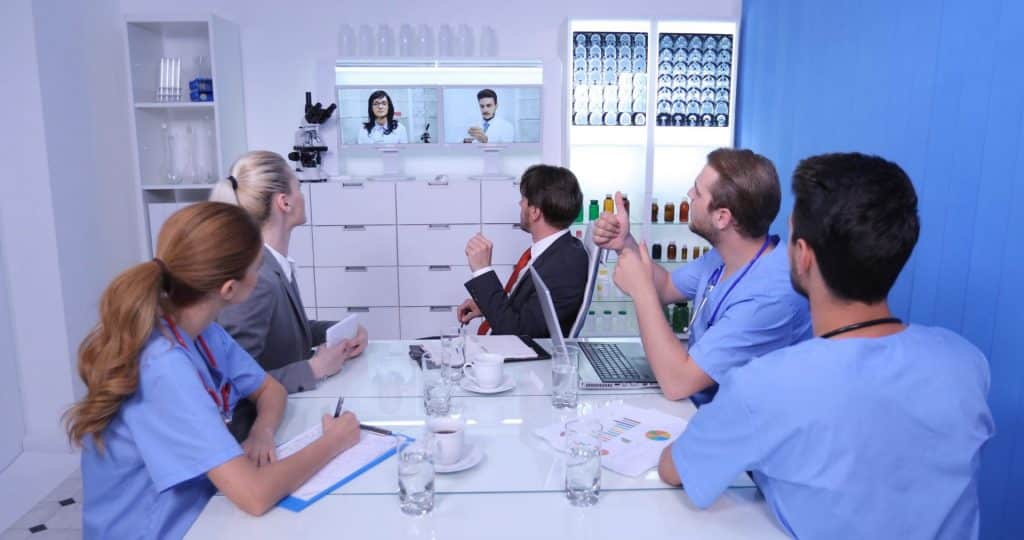What is healthcare training?
Healthcare training involves a strategic plan to equip medical staff with the essential skills and abilities that help them navigate the ever-changing medical landscape.
Patient care requires competency, dedication and attention to detail. By implementing proper healthcare training strategies, you will ensure that your employees are ready to face the challenges of being a healthcare employee.
Benefits of healthcare training
Effective healthcare training will help you prep employees who are ready to handle any issues that come their way. You will also have a better chance of retaining the top performers because of better employee engagement.
A 2020 Stanford Medicine Health Trends Report 47% of physicians and 73% of medical students stating that they look for additional training resources so they can stay informed about the latest healthcare innovations.

• Ensuring staff is prepared to handle any situation
One of the most important objectives of healthcare training is to ensure that the staff is well-prepared to deal with conflicts and challenges that might arise at work. Healthcare can sometimes demand an objective, level-headed nuanced approach even when things are tough, and your employees should be able to deliver.
• Keep employees motivated
When working in healthcare, one cannot avoid seeing pain and suffering. This can sometimes demotivate employees and cause them to become inattentive. It is up to you to motivate your employees constantly and keep them on their toes. Healthcare training can increase employee engagement and encourage them to keep improving.
• Risk management
Healthcare training will allow your employees as well as your patients to stay out of harm’s way. Knowledgeable employees will be likely to commit fewer on-the-job accidents, which will reduce the possibility of malpractice suits. Your employees should know about all the rules of conduct and the consequences their actions might have. Training is a great way of giving them real-world experience through simulations and case studies.
· Better patient care
Employees who understand their responsibilities clearly will be able to give higher-quality care to patients. Training will help them develop the skills they need to safeguard both the physical and emotional health of patients.
· Increase employee retention
The healthcare industry is constantly seeing new developments and breakthroughs. Professionals want to receive training consistently from their employers. Training can help them strengthen core skills and widen their knowledge base. Well-trained employees tend to have higher job satisfaction and they are more likely to stay.
Healthcare training topics
There are a number of important topics that you should cover in your healthcare training plan.
· Workplace safety
Knowing the workplace safety protocols will allow your employees to be more cautious. You have to cover basics like proper waste clean-up processes and slip-and-fall prevention alongside equipment usage rules. Healthcare employees such as nurses have to be ready for the physical strain associated with their work.
· Communication and conflict handling
Healthcare employees have to develop conflict resolution skills to handle escalating situations with co-workers and patients. They have to be particularly careful when talking to patients, even if they are being difficult. Being empathetic to patients who are going through a rough time and allowing them to vent is important. All patients have to be respected.
· Violence and sexual harassment
Having a strict anti-violence and anti-harassment policy is necessary in today’s day and age. Outline the important clauses and inform your employees about the consequences of going against the policy. A no-tolerance approach works best when it comes to ensuring a peaceful and positive work environment. Protect your employees and they will deliver their best performance.
· Fire safety
Fire safety protocols are one of the first things to cover in healthcare training. Hospital and nursing home employees have to learn how to deal with fire emergencies because patients rely on them completely for their safety. Fire training simulations can help employees get familiar with the evacuation process.
· Employee health resources
While working in healthcare, employee expect to have access to health resources of their own which allows them to take care of themselves. Tell them about the benefits and resources they can avail of as part of the training process.
· Online safety
With the healthcare industry creating a strong online presence, healthcare cybersecurity is more important than ever. Employees have to be very careful about protecting the identities of patients and maintaining the organizational database.
· Patient Rights
All healthcare employees have to know the patient rights as devised by your organization and other regulatory bodies. They have to communicate with patients transparently and give them the correct information.

Compliance in healthcare
Compliance training is an important part of your healthcare training plan. It will inform employees about the rules, regulations and policies they are expected to follow within the organization.
A survey by Elucidat found that 44% of healthcare services employees were dissatisfied with their mandatory compliance training and did not feel prepared to deal with the possible challenges. Your healthcare compliance training plan should cover all the basics in theory and help employees understand their relevance in real life.
For example, two of the most important subjects to cover under compliance in US healthcare compliance training are:
• HIPAA Violations
The Health Insurance Portability and Accountability Act of 1996 (HIPAA) protects sensitive patient health information by preventing the disclosure of medical information without the patient’s consent or knowledge. All healthcare providers have to abide by the HIPAA Privacy Rule. HIPAA violations can lead to serious consequences for employees.
According to a 2020 survey in the United States, 74% of clinical leaders offered training related to privacy and Health Insurance Portability and Accountability Act (HIPAA) to their staff, while 12% reported that the training was still in development.
• Stark Laws
The Stark Law acts as a healthcare fraud and abuse law that prevents healthcare employees from exploiting their employees financially. It prevents physicians from referring patients for designated health services to an entity with whom they share a financial bond that could have otherwise been paid for by Medicare.
Training for nursing home employees
When designing healthcare training programs for nursing homes, you should include the following:
• Understanding the role of a nursing home employee
As a nursing home employee, it is important to know one’s role and duties clearly. There might be some overlaps here and there since nursing homes are relatively smaller organizations, but a clear designation of roles will boost productivity and efficiency.
• Responsibilities of care
Training in nursing homes requires an extensive discourse on the different responsibilities of care that employees will have. The staff will have to cater to different types of patients with different sets of problems, but the responsibilities of care will remain the same for everyone.
• Working in a person-centric way
Working in a person-centric way means that nursing home employees will be able to meet the needs and follow the preferences of patients. They can develop closer and more personal relationships with patients, which will help them go the extra mile for every patient.
• Privacy and dignity
Patients are completely dependent on nursing home employees and it is important to respect that relationship. Protecting the privacy and dignity of every patient is as important as medically treating them. The staff should protect any information given to them confidentially.
• Safeguarding the patient
Every nursing home needs to look to protect patients and acting in their best interest.
• Health and safety
Employees need to be aware of the health and safety protocols of the organization. The training should not only cover them theoretically, but also provide practical examples so that employees know how to handle different situations.
Types of training for hospital employees
For training hospital employees, you can opt for the following methods of training:
· On-the-job training
This involves learning by doing. Employees understand more about their role and responsibilities as they meet their short-term goals. On-the-job training includes shadowing which allows employees to accompany more experienced professionals as they go about their day. They can also work under a mentor or as an aide to learn more about patient care and organizational protocol.

· Virtual training
Virtual healthcare training is a flexible method of training employees even as they attend to their daily duties. There are different modes of online training that you can opt for, and with technological advancements the choices are increasing every day.
For example, nurses can watch nurse training videos that are instructional or demonstrative in nature.Doctors can refer to virtual flashcards when they want to refresh their memory about a particular topic.
Healthcare training solutions
The following healthcare training solutions will improve your plan tremendously:
· Mobile Learning
According to Towards Maturity, 64% of learners think that it is essential for them to access their training content from their mobile device. As you distribute more virtual content, your employees will prefer accessing it when they are at ease. Since mobile devices are always nearby, it is easy to pick up right where one left off.
· Microlearning
Microlearning or learning in short bursts through engaging modules has become very popular and for good reason. According to EdApp, microlearning can boost engagement from an average of 15% up to 90%. The speed of development increases for microlearning modules while development costs are cut by 50%.
You can make your own custom training modules by recording short and engaging videos with the help of Bites. Employees can view the bite-sized content as and when they find time. You can also track their progress via the dashboard.
· Video-based training
Visual learners are able to understand and retain information better when they watch videos instead of reading text documents. Video-based learning is relevant for a practical industry like healthcare.
With Bites, you will be able to create demonstrative, instructional and trial videos for your healthcare employees. You can make a playlist covering different subjects and share it with them. These short videos are accessible, engaging and more likely to appeal to learners.
· Case studies and roleplay
Theoretical knowledge is not sufficient for healthcare employees. They have to know about the real-world applications and implications of everything they learn. Discussing case studies with them and asking for their opinions is a great way to get started. You can also encourage your employees to roleplay in made-up scenarios to evaluate their progress. With Virtual Reality (VR) training becoming more accessible, simulation training will enjoy greater popularity in healthcare.

5 Steps to Improve Healthcare Training
You can take the following steps to improve healthcare training:
· Assess the training needs of employees
Individualized training requires you to assess the training needs of individual employees and customize the training process accordingly. Once you know the strengths and weaknesses of your employees, you will be able to prepare them for the job more effectively.
· Set objectives and goals
Convey the objectives of your organization to your employees and make your expectations clear. Set short-term goals for them to achieve so you can test their progress and set long-term goals that will push them to work harder.
· Devise training initiatives
It is important to change your training for healthcare workers based on their reception and feedback. Come up with new training strategies and experiment with different methods so that employees feel engaged and motivated.
· Constant evaluation
Healthcare is sensitive, and you have to ensure that your employees are adequately trained. Monitoring their progress and testing them from time to time will keep employees on their toes. Take a look metrics and their performance trends so you can decide how to advance.
· Use latest technologies
The latest training technologies are revolutionizing how organizations are training employees. Artificial Intelligence (AI) has made it easier than ever to personalize the learning process. On top of that, Virtual Reality or VR makes it easy to simulate surgeries, crises and equipment usage for more efficient workers.
Summary
The landscape of healthcare training education is rapidly changing and your organization will benefit from staying up to date with the latest development. Virtual training is flexible and encourages microlearning which can increase knowledge retention significantly. You can use Bites to provide short and engaging training modules to employees. Bites will allow you to provide efficient and effective training in a cost-effective manner.




